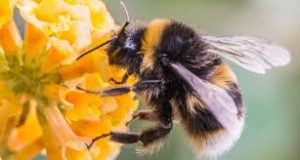01
Mar
Assessment Finds Alternatives Negate Any Need to Use Bee-Toxic Neonicotinoids
(Beyond Pesticides, March 1, 2018) A comprehensive review of notorious, bee-killing neonicotinoid insecticides finds that crop yields  and on-farm profit can be maintained and improved by replacing these toxic chemicals with alternative pest management strategies. The new study is part of an ongoing update to the 2014 Worldwide Integrated Assessment undertaken by an international team of scientists called the Task Force on Systemic Pesticides. The results of this review point to the need for strong action against these chemicals by all levels of government.
and on-farm profit can be maintained and improved by replacing these toxic chemicals with alternative pest management strategies. The new study is part of an ongoing update to the 2014 Worldwide Integrated Assessment undertaken by an international team of scientists called the Task Force on Systemic Pesticides. The results of this review point to the need for strong action against these chemicals by all levels of government.
“Regulators need to realize that if we want sustainable agricultural practices, we need a more restrictive regulatory framework and programs to support farmers making the switch,” said Task Force co-chair and scientist at France’s National Scientific Research Centre Jean-Marc Bonmatin, PhD, in a press release. “Our findings on the availability of alternatives will be particularly relevant where new restrictions on neonics are being considered.”
The Task Force reviewed 200 studies on systemic insecticides, looking at their use and pest resistance in annual and perennial crops, the viability of alternative pest management techniques, and the potential to implement alternative forms of crop insurance to cover risks, rather than spray expensive insecticides.
For perennial crops, researchers focus on the use of neonicotinoids to manage pests in fruit orchards and vineyards. Given mixed reports on the efficacy of neonicotinoids to control problem pests, the Task Force established strong evidence for the viability of alternative pest management techniques. Common moth pests, for instance, could be managed effectively by disrupting mating patterns through the use of pheromones. Exclusion netting with insect-proof screens could control both moths and increasingly problematic pests such as the brown marmorated stink bug. The use of biological control agents, such as parasitoids, insect-killing fungi, and other pest predators, could eliminate neonicotinoid use to control aphids and certain moth species. Likewise, ecological engineering, by planting habitat suitable to pest predators, can effectively knock down a range of pests, including aphids, mealybugs, thrips, and moths.
In annual crops, the main use of neonicotinoids is prophylactic, as the chemicals are usually applied to the seed of corn, soy, canola, and other row crops. Researchers found in the literature that a significant amount of neonicotinoid use could be abated by more thorough pest level evaluations. For example, major developments in modeling the prevalence of wireworm, a major pest in corn, enables a low-cost and reliable method to address the pest through less toxic means before their population gets out of hand. The literature on ecological engineering also appeared promising, with studies indicating that by incorporating flowers strips into rice fields, insecticide use could be reduced by 70% while increasing yields 5%.
Given the focus on less toxic, low cost management methods, the Task Force reviewed the practicality of a mutual fund risk insurance model to pay farmers when pest outbreaks do occur. Such an approach was piloted for corn farmers in Italy, with the results analyzed by researchers. As opposed to private crop insurance, a mutual fund insurance model is managed by a collective of farmers, who may a nominal fee per hectare (a hectare is ~2.5 acres) into the fund. As part of the collective, farmers are encouraged to follow strict integrated pest management principles and only use insecticides as a last resort. They are allowed to withdraw from the fund not only for pest damage, but also flooding, freezing, cold, drought, or loss from wildlife. The results of a two-year pilot saw 47,000 hectares covered under the fund, with the cost to buy in at ~3.3 euros ($4) per hectare, a tenth the price of an insecticide treatment to the same fields. The fund sat at 160,335 euros (~$200,000), and paid out roughly 84,000 euro (~$103,000), a little over 50% of the revolving fund.
“Crop insurance programs can be tailored to reduce the financial risk to farmers from potential pest infestations without the environmental costs of insecticide use,” Dr. Bonmatin said. “And on a cost-recovery basis, insurance premiums are far cheaper than insecticides, so farmers’ net incomes rise, too. It’s a win-win approach for farmers and the environment.”
The U.S. Environmental Protection Agency (EPA) determined as far back as 2014 that neonicotinoid seed treatments provide little to no benefit to farmers. However, in contrast to the European Union, which is currently considering whether to make a ban on these chemicals permanent, EPA continues to acknowledge the risks of these chemicals, yet do very little to encourage even a reduction in their use. To date, all the agency has done is add new label language widely criticized as inadequate and disproportionate to the risk these chemicals present pollinators.
The Task Force on Systemic Pesticides’ update to the Worldwide Integrated Assessment should put lawmakers and regulators at ease when determining whether to ban these hazardous insecticides. Not only are there a range of alternative pest management strategies available to address the pests neonicotinoids target, but the success of the mutual fund insurance model provides an economic replacement to the use of toxic neonicotinoids to avert the risk of crop loss.
Further research from the comprehensive Worldwide Integrated Assessment can be viewed on the Task Force’s webpage. And for more information about what you can do to stop neonicotinoids from harming pollinators, wildlife, and ecosystems, visit Beyond Pesticides’ Bee Protective webpage.
All unattributed positions and opinions in this piece are those of Beyond Pesticides.
Source: EurekAlert Press Release, Environmental Science and Pollution










